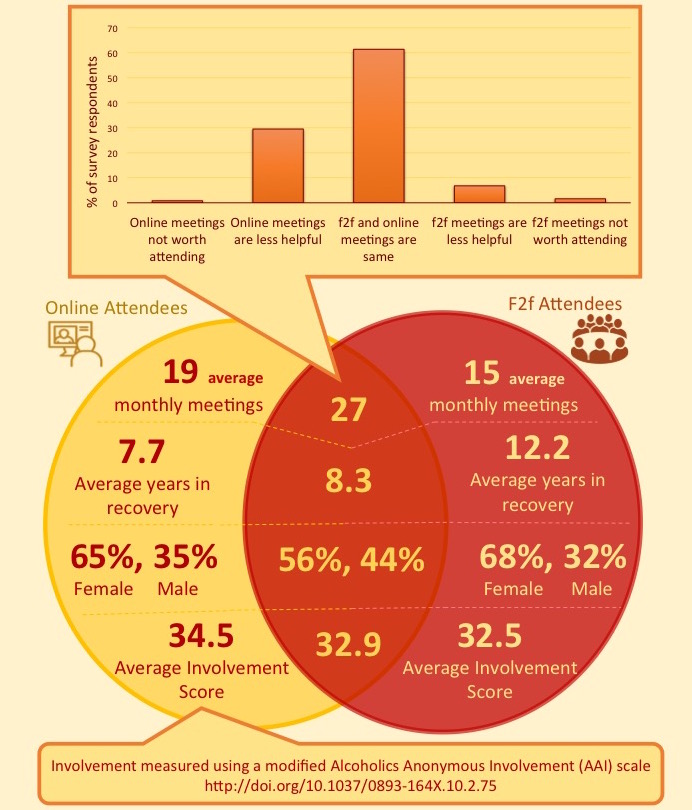An Alcoholics Anonymous meeting begins. The chairperson welcomes attendees, leads an opening prayer, and asks volunteers to read the fellowship’s readings, such as the 12 Steps. Next, the chairperson introduces a discussion topic and attendees queue up to speak about their experience, strength, and hope. This may sound familiar to anybody who has done work with recovery communities, except for one unusual aspect—this entire meeting is taking place online, with participants joining using their microphones and webcams through the InTheRooms.com online community.
When we began investigating the phenomenon of online video meeting for AA and NA, a lot of people questioned whether technology should have a place in recovery. Are these video meetings just reaching young people? Would anybody with a lot of recovery time really go to a meeting like that? Are people going to use online meetings to replace the much more meaningful face-to-face (f2f) traditional twelve-step meetings? To try to get some insights into who goes to online meetings and how these fit into people’s recovery programs, we designed a mixed methods investigation, combining quantitative data from an online questionnaire deployed on InTheRooms.com (N = 285) and a qualitative semi-structured interview investigation with active meeting attendees (N = 14).
We distributed the questionnaire as a paid banner advertisement on InTheRooms.com, as well as through a short article about the study through the website’s front-page blog and weekly newsletter. A total of 385 people attempted and 285 people completed the questionnaire. It included questions about demographics, recovery history, and meeting attendance, as well as the 7-item AAI (Alcoholics Anonymous Involvement scale). We discuss our findings broken into three categories of respondents: those who reported only attending face-to-face meetings (N = 64), those who reported only attending online meetings (N = 43), and those who reported attending both types of meeting (N = 148).
Who Attends Online Meetings?
We summarize the differences between these three groups in the infographic below. We found that our respondents on average had quite a bit of sober time (7.7 years for online only, 12.2 years for face-to-face only, and 8.3 years for both). We found that online recovery was not just for young people—the average age of online only meeting attendees was 52 and those who combined both types of meetings were on average 56 years old (face-to-face only meeting attendees were 50 years old on average). Regardless of what kinds of meetings they attended, our respondents had similar scores on the AAI scale (32.5 for face-to-face only, 34.5 for online only, and 32.9 for combining both), meaning that they were all fairly strongly involved in their own recovery programs. One striking element to notice about these three groups is in the frequency of meeting attendance. Those who attend only face-to-face meetings reported 15 meeting per month and those attending only online reported 19 meetings monthly, but those who combined both types of meetings reported attending 27 meetings per month. But of course, quantity is not the same as quality—are online meetings perceived to be helpful?

How Do Online Meetings Compared to Face-to-Face Meetings?
For those 148 respondents who mentioned attending both types of meetings, we asked them to explicitly compare their experience with online and face-to-face meetings. The majority of these respondents (61%) found face-to-face and online meetings to be equally useful and helpful for their recovery. However, 30% of respondents found online meetings to generally be less helpful (while only 9% thought that face-to-face meetings were less helpful). Overall, participants who tried both types of meetings, still found face-to-face meeting to be an important part of their recovery program. This leads to the question: why would people attend online meetings if there is a chance that they may not be as helpful?
To answer this question, we supplemented questionnaire responses with 14 in-depth semi-structured interviews with participants who volunteered for further follow-up after the questionnaire. All of the interviews were conducted via phone or videochat, recorded, transcribed, and analyzed using data-driven thematic coding.
Why Do People Attend Online Meetings?
Most of our interview participants recommended a hybrid approach of attending both types of meetings, pointing out that “a combination of the two really is the best, then you get the best of both worlds.” Interview participants appreciated the immediacy of online meetings—because attendees are from around the world and in many different time zones, support is “available around the clock.” Interview participants also valued the diversity of perspectives available online: “you get the ability to hear from people from east to west coast, all over the world, different perspectives about the program as it is in different places—the variety of experience, strength, and hope is far greater.” Of course, online meetings were not perfect. Respondents worried that online spaces may make maintaining anonymity more difficult and may make it harder to consistently enforce group norms without excluding anybody (these are really interesting and nuanced ideas which deserve more in-depth discussion, so we really encourage you to read the paper for more). But most of all, online meetings lacked the kind of physical contact that is such a big part of face-to-face AA. As one participant said, “to me that physical contact is really really important. It makes me feel human.”
Given that most people in interviews recommended combining online and face-to-face meetings, why would somebody attend exclusively online? In the questionnaire, we asked respondents who attended meetings online to discuss their reasons. For the plurality of respondents (30%), lack of transportation was the primary reason for attending meetings exclusively online and participants reported this being particularly problematic in rural areas. Other reasons included health problems or disabilities that restrict mobility (19%) and work scheduled during meeting times (12%). These were people who were not reached by standard meetings and several of them mentioned that online meetings saved their life.
What do our findings mean for helping your clients achieve and maintain sobriety?
To find out more about our methods and get more details about our findings, please refer to our CSCW 2017 paper (available without charge).
About the Authors
 Svetlana “Lana” Yarosh (http://lanayarosh.com/) is an Assistant Professor in the department of Computer Science & Engineering at University of Minnesota. Her research focuses on understanding and creating technology to support people in recovery from substance use disorders. Lana has two Bachelors of Science from University of Maryland (in Computer Science and Psychology), a Ph.D. in Human-Centered Computing from Georgia Institute of Technology, and two years of industry research experience with AT&T Labs Research.
Svetlana “Lana” Yarosh (http://lanayarosh.com/) is an Assistant Professor in the department of Computer Science & Engineering at University of Minnesota. Her research focuses on understanding and creating technology to support people in recovery from substance use disorders. Lana has two Bachelors of Science from University of Maryland (in Computer Science and Psychology), a Ph.D. in Human-Centered Computing from Georgia Institute of Technology, and two years of industry research experience with AT&T Labs Research.
 Sabirat Rubya (http://www-users.cs.umn.edu/~rubya001/ ) is a Ph.D. student in the GroupLens Research Center in the department of Computer Science & Engineering at University of Minnesota. Her research focuses on recommending and designing better technology for users of online peer support health communities. She completed her bachelors in Computer Science and Engineering from Bangladesh University of Engineering and Technology. Before starting her Ph.D., Sabirat worked as a mobile application developer and as a lecturer.
Sabirat Rubya (http://www-users.cs.umn.edu/~rubya001/ ) is a Ph.D. student in the GroupLens Research Center in the department of Computer Science & Engineering at University of Minnesota. Her research focuses on recommending and designing better technology for users of online peer support health communities. She completed her bachelors in Computer Science and Engineering from Bangladesh University of Engineering and Technology. Before starting her Ph.D., Sabirat worked as a mobile application developer and as a lecturer.